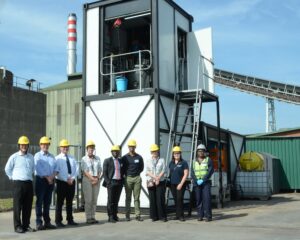Press release: Strategic Water Partners Network South Africa
With the gap between supply and demand for water expected to reach 17% by 2030, many South Africans will be required to radically change their attitudes to the way in which this precious commodity is being used and conserved, especially in the treatment of human waste.
Population growth coupled with a rise in urbanisation and increased economic activity are key contributors to the growing demand for water, while poor usage habits, the denigration of wetlands, climate change and consumer and commercial losses are factors causing the availability of this valuable resource to dwindle.
With an estimated 11% of households still without sanitation services, and 26% with sanitation services which do not meet the required standard, the public health and environmental risks are enormous. In a water-scarce country like South Africa, the solution cannot be ‘flushing’. Instead, game changing new technologies which require little or no water, are required if the country is to address the sanitation challenge and the looming water gap.
Jay Bhagwan, Executive Manager at the Water Research Commission, and representative of the Strategic Water Partner Network (SWPN), agrees with Water and Sanitation Minister, Nomvula Mokanyane that, ‘It’s not all about flushing…’, and comments that universal access to sanitation does not mean that everyone must be able to flush but rather that there is universal access to a more appropriate way of treating human wastes – faeces and urine. “We need to build a culture which embraces the sustainability of water and recognises the benefits of treating human wastes as an asset rather than a liability”, he says.
Sanitation makes up about 60% of the capital costs of water services and between 30% and 40% of water is used for flushing. But while South Africa is one of few countries which returns up to 68% of water for indirect use, sludge should be viewed as a resource:
- the energy, nutrients and reuse of which provides an opportunity to recover phosphates and nitrates for fertilization;
- to convert sludge into biogas for power; and
- to recover water from flushing.
While there is some progress on effluent re-use within certain municipalities, the challenge of treating waste relating to sanitation remains. Current modalities for collection and removal of waste are often messy and hazardous to health whereas a flush toilet and central sewage system is viewed by society as the optimal method of disposal. In many cases this is not sustainable in the longer term. Instead, alternative thinking is required for solutions which:
- result in less or no waste water and sewage;
- treat the effluent at source;
- result in beneficiation;
- deliver the same user convenience as a flush toilet; and
- saves water while being environmentally safe.
Dry technologies, through processes which involve, dehydration; desiccation; solar treatment; combustion and the like are promising and could provide the solution which is so urgently required. SWPN is made up of some of South Africa’s most forward-thinking corporates along with the Department of Water and Sanitation (DWS), municipalities, civil society and other stakeholders. Many of these progressive organisations have taken the lead in developing innovative, water-efficient solutions in the interest of sustainable socio economic growth for the country.
One such project is the Green Drop initiative, led by the DWS. This incentive-based regulatory programme assesses and evaluates the management of more than 800 wastewater treatment facilities by 156 municipalities. Especially relevant in agricultural areas where grey and effluent water are utilized for irrigation, this initiative provides tools for municipalities to assess and evaluate waste water quality, sample analysis credibility, process control and treatment facilities. Given the public health risks associated with ecoli and other harmful micro-organisms, compliance monitoring is vital in ensuring safe produce.
Municipalities, like Witzenberg in the heart of the Western Cape’s fruit growing region are testament to the positive commercial impact this initiative has had on its farmers and consumers. However, in other municipalities where treatment of sewage has not been optimal and levels of harmful bacteria have exceeded safe limits, there has been a negative impact on commercial trade.
Various organisations within the voluntary yet carefully structured SWPN platform have embarked on ground-breaking initiatives which utilize lower quality water in the interest of preserving the country’s water resources.
- Notable amongst these include Khumba Iron Ore’s Sishen mine in the Northern Cape which is part of the Anglo American Group. This mine uses effluent from the wastewater treatment works for its processing operations whilst injecting the groundwater abstracted from the mines into the potable water supply.
- Other exemplary leaders in this respect are the cities of Cape Town, Nelson Mandela Bay and Johannesburg which recycle effluent from their wastewater treatment works for industrial use, irrigation and cooling water in power stations.
Richard Holden, speaking on behalf of the SWPN comments that industries should think twice before using potable water if lower quality water is available and will do the job just as well.
The recently released Draft National Sanitation Policy as well as the Medium Term Strategic Framework of the NDP recognise the need for reforms which encourage new thinking around sanitation and the treatment of effluent. The SWPN anticipates that this draft policy will go a long way to address the socio-cultural aspects of poor sanitation and will pave the way for new innovations in the treatment of effluent.
Furthermore, while its members are committed to broadening their focus beyond the factory fence to ensure that their employees and extended communities are not negatively affected by poor sanitation, other organisations should follow their lead. Sustainable sanitation and potable water solutions that meet the needs of the population necessitates a collaborative effort by consumers, industry stakeholders and government and the SWPN, its members and partners are committed to working together with government to find mutually beneficial, viable solutions in the interest of all South Africans.



